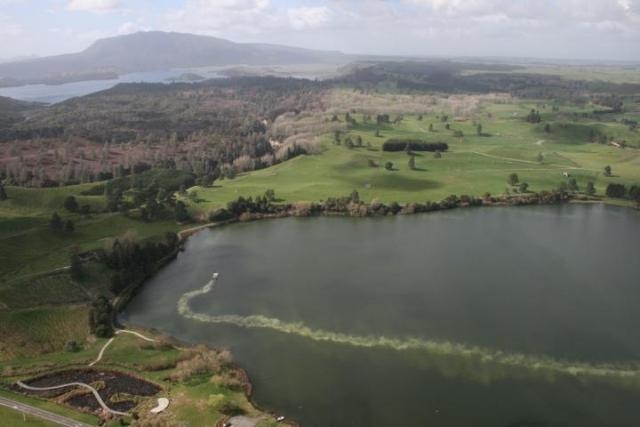Jun 7 2016
The biggest cause of water quality degradation around the world is phosphorus. It causes ‘dead zones’, toxic algal to bloom, poses more health risks for the animals, plants, and humans that are exposed to the polluted waters, and leads to loss of biodiversity. This in turn could lead to loss of economic and social profits based on freshwaters upon which society is dependant.
 Geo-engineering applications of a modified zeolite product called "Aqual-P" at Lake ?karo, New Zealand. (Photo credit : Image courtesy of Andy Bruere, Bay of Plenty Regional Council, New Zealand.)
Geo-engineering applications of a modified zeolite product called "Aqual-P" at Lake ?karo, New Zealand. (Photo credit : Image courtesy of Andy Bruere, Bay of Plenty Regional Council, New Zealand.)
In a special issue of Water Research, a collection of studies have been published, where leading scientists evaluate how geo-engineering in lakes can manage phosphorus pollution.
After several years of run-off from human sewage, agriculture, and industrial practices, phosphorus has started piling up at the bottom of lakes at an alarming rate. This problem seems overwhelming as it is, and man continues to pollute the freshwaters with nearly million tonnes of phosphorus annually.
Continuous monitoring activities post the control of phosphorus sources to lakes reveal that it takes a number of years for the animals and plants to recover. This is due to the release of phosphorus stored in the lake bed sediments into the water column.
Society is now faced with two choices. One is to ramp up recovery by applying geo-engineering to cap sediment phosphorus stores. The other is doing nothing and just accepting poor quality freshwaters in the years to come.
Geo-engineering is expensive and debatable, and its side effects are not well established. The special issue comprises the work of 60 authors from 12 countries to enumerate all the facts on this method.
The scale of this problem has driven the development of a vibrant green economy sector. Our special issue uncovered an alarming number of emerging materials being proposed for use in lakes. The potential for unintended side effects when using novel untested materials is high. A common conclusion of a number of papers was that it is essential to conduct comprehensive assessments of candidate lakes prior to any treatments. We reviewed these considerations in our editorial paper and stress the need to ensure the safe and effective use of this approach.
Miquel Lürling, lead author and guest editor, Freshwater Ecologist, University of Wageningen, the Netherlands
With the latest introduction of water quality targets and time limits for standing waters including the Clean Water Act in the USA and the EU Water Framework Directive, the need for methods such as geo-engineering is increasing. Nearly 40% of lakes in Europe are not passing current water quality stipulations and the combined economic losses in the USA connected with high phosphorus levels in freshwaters is predicted to be at $2.2 billion annually. There is a need to create methods that efficiently control phosphorus pollution in freshwaters.
This special issue combines a number of field scale and laboratory experiments to prepare a highly comprehensive analysis of this method for management of phosphorus till date.
Our papers assessed the ecological and chemical responses across over 100 lake treatments from around the world. It’s safe to say the approach is widespread and global. Most case studies used either aluminum salts or lanthanum modified bentonite additions to control phosphorus. The responses were highly variable across the lakes. In some cases dramatic and sudden improvements were reported in chemical and ecological quality, in others nothing really happened, or the responses were short lived. To improve confidence in the use of the approach a series of papers presented models to predict responses in candidate lakes. One key conclusion is that although this mitigation approach is promising when used correctly and in combination with catchment management, it should not simply be used to off-set the effects of poor environmental behavior.
Bryan Spears, lead author and guest editor, Freshwater Ecologist, Centre for Ecology & Hydrology, UK
Geo-engineering in lakes is also being the objective at other environmental issues. Upcoming methods include the control of toxic cyanobacteria for human health and the control of greenhouse gas emissions from lakes.
For instance, geo-engineering methods were used in the 2014 Glasgow Commonwealth Games, the 2012 London Olympic Games, and may be applied in the 2016 Rio Olympic Games to ensure tolerable levels of health risk to athletes participating in open water events.
The special issue was guided by the University of Wageningen (The Netherlands), The Centre for Ecology & Hydrology (UK), and the University of Southern Denmark (Denmark).